Great to see Salix mentioned in the forums. I especially love the little ones and have grown them in the past (but not now...). I believe them to be among the most underappreciated plants. Thanks for posting.
Salix mysinites is new to me but I am very familiar with reticulata as they are common in northern Newfoundland. I am at my brothers home in Calgary so have no access to my pictures, but other Newfoundland native willows which are very desiable are S. vestita, S. jejuna, S. calcicola, S. glauca (hugh variation in this species), S. weigandii, S. arctica, S. arctophila (just saw some of these in Glacier National park), S. uva-ursi (our only acid-loving species) and S. candida (this one is only suitable for larger rock gardens but have fantastic silver-white foliage). I think northern newfoundland has some of the best varieties and most diversity of dwarf willows of anywhere in the world....go figure.
Trond, are you sure your S. glauca is the real thing? Glauca means smooth with a waxy bloom.....it is a common willow here but always smooth leaves (new ones may be a little hairy but this is lost as the leaves mature). Your 'glauca' looks very much like our native S. candida (or the European S. helvatica). If it really is glauca, then the Norway forms are very special indeed.
Trond, are you sure your S. glauca is the real thing? Glauca means smooth with a waxy bloom.....it is a common willow here but always smooth leaves (new ones may be a little hairy but this is lost as the leaves mature). Your 'glauca' looks very much like our native S. candida (or the European S. helvatica). If it really is glauca, then the Norway forms are very special indeed.
I am not 100% sure. The Norwegian S. glauca has many forms and some can be hairy on both sides of the leaves. Neither candida nor helvetica occur here at all. We have 3 species with blue and more or less hairy leaves: lanata, glauca and lapponum. What I pictured is not lanata; and glauca and lapponum differ in taste of the leaves and size of catkins. I think I tasted the leaves too (glauca tastes bitter). But this shrub grew among other not so hairy ones. Lanata grew near by, I don't know if they can hybridise (many other hybrids are known).
Wow, those silver Salix are amazing. :o Never seen anything like them before.
Sorry for activating this topic after so many months, but I've only just joined and exploring, so I'm finding lots of old topics that haven't been touched for a while. I hope it is OK to post in them? I just couldn't resist commenting on these silver willows....... they'd look brillliant in a garden situation as well, I'd imagine?
If it is interesting to you, Paul, than it is interesting to others too. Digging up old threads like this is a good thing, especially since we are gaining more forum participants, with the open enrollment for the public, that haven't seen them before. They are nice reminders for us who have been here from the beginning too. --------------------- Trond, I somehow missed (before) your last entry here! (So thanks for bringing this topic back, Paul...) We don't have willows like this native to Minnesota, but those last two photos sure make me yearn for the crisp, cool lake mornings of northern Minnesota.
Wow, those silver Salix are amazing. :o Never seen anything like them before.
Sorry for activating this topic after so many months, but I've only just joined and exploring, so I'm finding lots of old topics that haven't been touched for a while. I hope it is OK to post in them? I just couldn't resist commenting on these silver willows....... they'd look brillliant in a garden situation as well, I'd imagine?
Revive whatever you want, Paul, and comment as well :o Willows are pretty common here, especially on higher grounds, but not often used as garden shrubs. Those found in nurseries are usually foreign types, the native ones are "too common" I think. I have one in my garden taken as a small plant but willows are easily propagated from cuttings.
So how big do the silver Salix species grow to? I wonder if they are already here in the country? Seed cannot come in through quarantine unfortunately, but I am wondering whether any of these came previously? There certainly ARE some miniature styles of Salix here in Aus, so they've been brought in at some point along the line. I just wasn't aware there were ones like these with the lovely silver leaves.
I see a lot of really beautiful (and presumably, at least some must be garden-worthy) alpine willows in the mountains here... I only wish I could put names to them. (According to Moss & Packer, there are 13 species that occur in alpine/subalpine habitats... so I think the odds are stacked against me!) Here are a few attractive ones seen in alpine/sub-alpine areas. Can anyone ID them?
1) Salix #1
2) Salix #2; plants in this thicket were up to ~1m tall.
3) Salix #3; low-growing but lanky/bare-stemmed. (I suppose it may be the same as the previous one but more dwarfed?)
Beautiful Salix Lori! I could easily become a Salix hound. I see that you're also making good use of the inline photo attachment capability, very nice... makes the text and photos become more of a dialog.
I'm still not able to connect to nargs.org for some mysterious reason, and I'm here at a public library using a PC to gain access :-\. I hope to resolve the technical glitch this coming week.
Some great salix in the rockies! In #7, the vestita is on the top and the reticulata is below. #5 is also reticulata. I have pics of that large catkin species as well but never got an ID.
So how big do the silver Salix species grow to? I wonder if they are already here in the country? Seed cannot come in through quarantine unfortunately, but I am wondering whether any of these came previously? There certainly ARE some miniature styles of Salix here in Aus, so they've been brought in at some point along the line. I just wasn't aware there were ones like these with the lovely silver leaves.
If the silvery species already are in Aus I can't possibly tell but the species here (Ss. glauca, lapponum and lanata) grow to about 1m.
Wow! lots of great willows! There are bazillions of them here, but they are mostly multistemmed large shrubs/small trees to maybe 6-10m, though usually less and needing support of other trees or a dense clump of their own growth to get that tall--also here they often occur in damp to wet pastures, and in those settings they get periodically bulldozed and regrow from the roots.. We have some pretty ones, for sure, and if pruned could be really nice in the garden, including some silvery leafed types, a lot of variety in stem colour and catkins as well, many are very showy through numbers, though not large...
I've admired a few in the mountains, as Lori and Todd mentioned, but was never there at the right time for seed, and only saw them in parks, so could not take cuttings :( We have one that my mother planted some years ago--a commercial variety--'arctic fox', or 'blue fox' or something like that-- maybe a metre and a half tall, nice, but not as white as Trond's forms! Also one survivor in my old rock garden I planted as a teen from a snippet from somewhere in the Rockies also a little over a metre, also not a really flashy one...
Cohan, maybe you'll show us again here on NARGS (for forumists who have not had the pleasure of seeing your extensive posts on SRGC), your photos of taller shrubby Salix species, but with early spring catkins of beautiful detail, color and form. I was quite taken with those photos and the detail captured.
Some great salix in the rockies! In #7, the vestita is on the top and the reticulata is below. #5 is also reticulata. I have pics of that large catkin species as well but never got an ID.
Thanks for the ID help, Todd. It would be ideal to see these things in the presence of a botanist who could really explain the differences. Failing that, I guess I'll have to study the field marks more and try to distinguish them.
Apologies for cross-posting this on the SRGC forum as well.
Could anyone kindly identify this dwarf salix from these poor images? A herbaceous species that has filled a twelve inch pan, has soft downy leaves and is flowering now at less than three inches tall - many thanks in anticipation.
Welcome suggestions have already been made regarding S. polaris and S. uva-ursi but neither seem to correspond exactly.
Great to see Salix mentioned in the forums. I especially love the little ones and have grown them in the past (but not now...). I believe them to be among the most underappreciated plants. Thanks for posting.
Why did you stop growing them if you don't mind saying. I'm thinking about growing them myself. Would they do well in z6b Southeastern climate?
Comments
BalistrieriCarlo (not verified)
Re: Two gardenworthy willows
Mon, 07/26/2010 - 6:11amGreat to see Salix mentioned in the forums. I especially love the little ones and have grown them in the past (but not now...). I believe them to be among the most underappreciated plants. Thanks for posting.
Todd Boland
Re: Two gardenworthy willows
Mon, 07/26/2010 - 9:10amSalix mysinites is new to me but I am very familiar with reticulata as they are common in northern Newfoundland. I am at my brothers home in Calgary so have no access to my pictures, but other Newfoundland native willows which are very desiable are S. vestita, S. jejuna, S. calcicola, S. glauca (hugh variation in this species), S. weigandii, S. arctica, S. arctophila (just saw some of these in Glacier National park), S. uva-ursi (our only acid-loving species) and S. candida (this one is only suitable for larger rock gardens but have fantastic silver-white foliage). I think northern newfoundland has some of the best varieties and most diversity of dwarf willows of anywhere in the world....go figure.
Trond Hoy
Re: Two gardenworthy willows
Wed, 07/28/2010 - 1:33pmI should like to explore the willows (and other plants) of Newfoundland, Todd!
Here are two other gardenworthy willows - I do not like them if I have to walk through them but otherwise they are rather showy.
First "sølvvier" (Salix glauca)
Trond Hoy
Re: Two gardenworthy willows
Wed, 07/28/2010 - 1:57pmThe second is "ullvier" (Salix lanata) by "Svartevatn" (= Black Lake).
Todd Boland
Re: Two gardenworthy willows ... and two more!
Wed, 08/04/2010 - 3:36amTrond, are you sure your S. glauca is the real thing? Glauca means smooth with a waxy bloom.....it is a common willow here but always smooth leaves (new ones may be a little hairy but this is lost as the leaves mature). Your 'glauca' looks very much like our native S. candida (or the European S. helvatica). If it really is glauca, then the Norway forms are very special indeed.
Trond Hoy
Re: Two gardenworthy willows ... and two more!
Wed, 08/04/2010 - 1:21pmI am not 100% sure. The Norwegian S. glauca has many forms and some can be hairy on both sides of the leaves. Neither candida nor helvetica occur here at all. We have 3 species with blue and more or less hairy leaves: lanata, glauca and lapponum. What I pictured is not lanata; and glauca and lapponum differ in taste of the leaves and size of catkins. I think I tasted the leaves too (glauca tastes bitter). But this shrub grew among other not so hairy ones. Lanata grew near by, I don't know if they can hybridise (many other hybrids are known).
Paul T (not verified)
Re: Two gardenworthy willows ... and two more!
Wed, 02/02/2011 - 4:00pmWow, those silver Salix are amazing. :o Never seen anything like them before.
Sorry for activating this topic after so many months, but I've only just joined and exploring, so I'm finding lots of old topics that haven't been touched for a while. I hope it is OK to post in them? I just couldn't resist commenting on these silver willows....... they'd look brillliant in a garden situation as well, I'd imagine?
Richard T. Rodich
Re: Two gardenworthy willows ... and two more!
Wed, 02/02/2011 - 10:32pmIf it is interesting to you, Paul, than it is interesting to others too. Digging up old threads like this is a good thing, especially since we are gaining more forum participants, with the open enrollment for the public, that haven't seen them before. They are nice reminders for us who have been here from the beginning too.
---------------------
Trond, I somehow missed (before) your last entry here! (So thanks for bringing this topic back, Paul...) We don't have willows like this native to Minnesota, but those last two photos sure make me yearn for the crisp, cool lake mornings of northern Minnesota.
Trond Hoy
Re: Two gardenworthy willows ... and two more!
Fri, 02/04/2011 - 11:57pmRevive whatever you want, Paul, and comment as well :o
Willows are pretty common here, especially on higher grounds, but not often used as garden shrubs. Those found in nurseries are usually foreign types, the native ones are "too common" I think. I have one in my garden taken as a small plant but willows are easily propagated from cuttings.
Would be too crispy today, Rick, wouldn't it?
Paul T (not verified)
Re: Two gardenworthy willows ... and two more!
Sat, 02/05/2011 - 12:45amSo how big do the silver Salix species grow to? I wonder if they are already here in the country? Seed cannot come in through quarantine unfortunately, but I am wondering whether any of these came previously? There certainly ARE some miniature styles of Salix here in Aus, so they've been brought in at some point along the line. I just wasn't aware there were ones like these with the lovely silver leaves.
Lori S. (not verified)
Re: Two gardenworthy willows ... and two more!
Sat, 02/05/2011 - 11:52amI see a lot of really beautiful (and presumably, at least some must be garden-worthy) alpine willows in the mountains here... I only wish I could put names to them. (According to Moss & Packer, there are 13 species that occur in alpine/subalpine habitats... so I think the odds are stacked against me!)
Here are a few attractive ones seen in alpine/sub-alpine areas. Can anyone ID them?
1) Salix #1
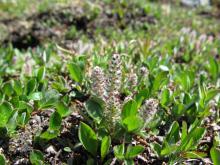
2) Salix #2; plants in this thicket were up to ~1m tall.
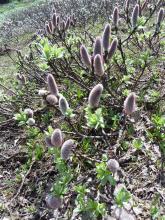
3) Salix #3; low-growing but lanky/bare-stemmed. (I suppose it may be the same as the previous one but more dwarfed?)
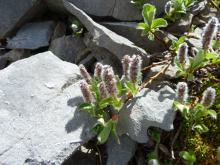
4) Salix reticulata... I think(?)

5) Salix vestita... ?? Covers the ground, reaching only ~1cm high, in many areas.
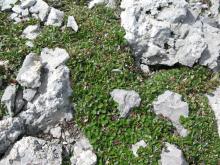
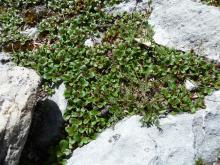
6) This is just a picture that I like... don't know the species of this Salix either.

7) A pretty Salix combo... possibly S. reticulata at the top and S. vestita below?
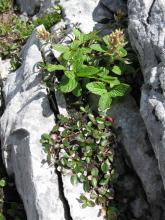
Mark McDonough
Re: Two gardenworthy willows ... and two more!
Sun, 02/06/2011 - 12:24pmBeautiful Salix Lori! I could easily become a Salix hound. I see that you're also making good use of the inline photo attachment capability, very nice... makes the text and photos become more of a dialog.
I'm still not able to connect to nargs.org for some mysterious reason, and I'm here at a public library using a PC to gain access :-\. I hope to resolve the technical glitch this coming week.
Todd Boland
Re: Two gardenworthy willows ... and two more!
Sun, 02/06/2011 - 5:31pmSome great salix in the rockies! In #7, the vestita is on the top and the reticulata is below. #5 is also reticulata. I have pics of that large catkin species as well but never got an ID.
Trond Hoy
Re: Two gardenworthy willows ... and two more!
Mon, 02/07/2011 - 4:30amIf the silvery species already are in Aus I can't possibly tell but the species here (Ss. glauca, lapponum and lanata) grow to about 1m.
Trond Hoy
Re: Two gardenworthy willows ... and two more!
Mon, 02/07/2011 - 12:28pmLori,
pretty willows!
#3 looks similar to S. lanata catkins and #5 looks similar to S. polaris - but I don't know if they grow over there ???
Well, when I looked better - I am not sure the similarities are striking ;)
Paul T (not verified)
Re: Two gardenworthy willows ... and two more!
Mon, 02/07/2011 - 1:50pmTrond,
So, perfect size for a garden then. ;D Thanks for the info.
cohan (not verified)
Re: Two gardenworthy willows ... and two more!
Sat, 02/19/2011 - 7:31pmWow! lots of great willows! There are bazillions of them here, but they are mostly multistemmed large shrubs/small trees to maybe 6-10m, though usually less and needing support of other trees or a dense clump of their own growth to get that tall--also here they often occur in damp to wet pastures, and in those settings they get periodically bulldozed and regrow from the roots..
We have some pretty ones, for sure, and if pruned could be really nice in the garden, including some silvery leafed types, a lot of variety in stem colour and catkins as well, many are very showy through numbers, though not large...
I've admired a few in the mountains, as Lori and Todd mentioned, but was never there at the right time for seed, and only saw them in parks, so could not take cuttings :(
We have one that my mother planted some years ago--a commercial variety--'arctic fox', or 'blue fox' or something like that-- maybe a metre and a half tall, nice, but not as white as Trond's forms!
Also one survivor in my old rock garden I planted as a teen from a snippet from somewhere in the Rockies also a little over a metre, also not a really flashy one...
Mark McDonough
Re: Two gardenworthy willows ... and two more!
Sat, 02/19/2011 - 8:32pmCohan, maybe you'll show us again here on NARGS (for forumists who have not had the pleasure of seeing your extensive posts on SRGC), your photos of taller shrubby Salix species, but with early spring catkins of beautiful detail, color and form. I was quite taken with those photos and the detail captured.
cohan (not verified)
Re: Two gardenworthy willows ... and two more!
Sat, 02/19/2011 - 8:55pmSure, Mark, I will photograph and post them as they start in the spring again--I finally got the Flora of Alberta, and another book that has a bit of a section on willows, so I'm going to start trying to id at least some of the locals!
Here are some from last year in April, so I have some time to wait yet!
https://picasaweb.google.com/cactuscactus/April182010NorthernSpringWillo...
https://picasaweb.google.com/cactuscactus/April212010NorthernSpringSunse...
and a third album from early May (these are not all willow pics!) shows, I believe, a different species..
https://picasaweb.google.com/cactuscactus/May022010NorthernSpring#
Lori S. (not verified)
Re: Two gardenworthy willows ... and two more!
Mon, 02/21/2011 - 9:03amThanks for the ID help, Todd. It would be ideal to see these things in the presence of a botanist who could really explain the differences. Failing that, I guess I'll have to study the field marks more and try to distinguish them.
Cliff Booker
Re: Two gardenworthy willows ... and two more!
Wed, 05/18/2011 - 2:38amApologies for cross-posting this on the SRGC forum as well.
Could anyone kindly identify this dwarf salix from these poor images? A herbaceous species that has filled a twelve inch pan, has soft downy leaves and is flowering now at less than three inches tall - many thanks in anticipation.
Welcome suggestions have already been made regarding S. polaris and S. uva-ursi but neither seem to correspond exactly.
killdawabbit (not verified)
Re: Two gardenworthy willows
Fri, 07/29/2011 - 9:12pmWhy did you stop growing them if you don't mind saying. I'm thinking about growing them myself. Would they do well in z6b Southeastern climate?